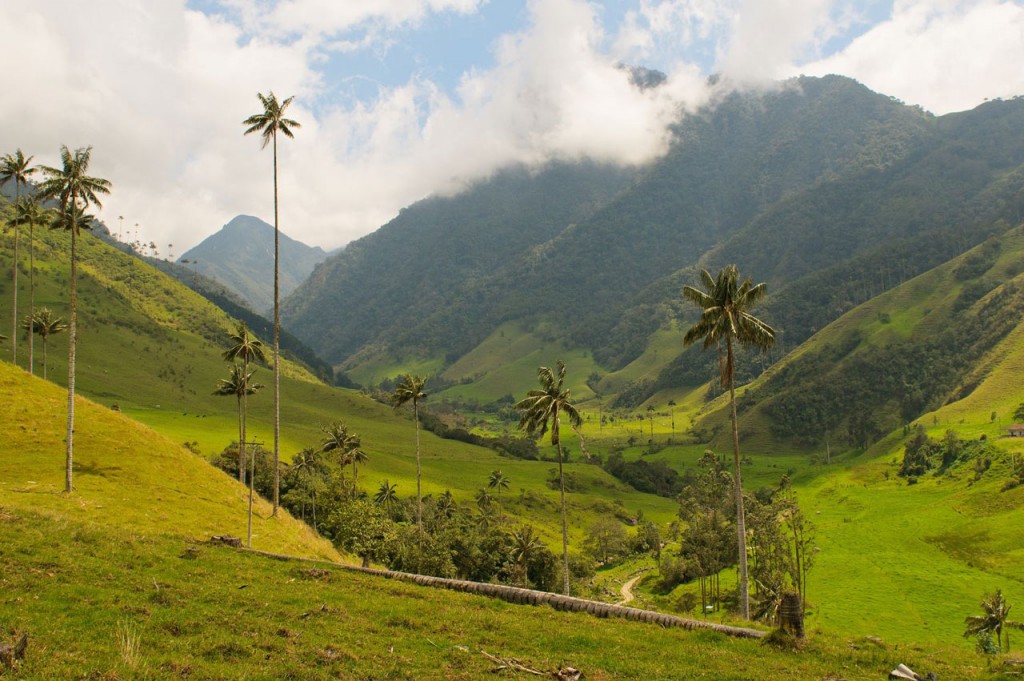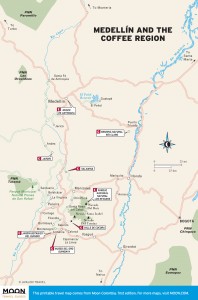
Wax palms in the Valle de Cocora. Photo © javarman javarman/123rf.

Medellín and the Coffee Region
On the western edge of the Parque Nacional Natural Los Nevados, the pueblo of Salento (pop. 7,000) is one-stop shopping for those seeking a quintessential coffee region experience. The town, an enchanting pueblo, home to coffee growers and cowboys, is adorned with the trademark colorful balconies and facades of Paisa architecture. It was one of the first settlements in the region during the 19th-century Antioquian colonization. In the nearby countryside, coffee farms dominate the landscape. Here you can be a Juan Valdez, the iconic personification of Colombian coffee, during a coffee tour in which you harvest coffee beans, learn about the bean-to-bag process, and sip the freshest coffee you’ve ever tasted.Within minutes of town is the Valle de Cocora, where you can play tree tag in forests of palma de cera (wax palm, the Colombian national tree), the skyscrapers of the palm family. Some of these can reach up to 60 meters (200 feet) high. For a more challenging hike continue on to the Reserva Acaime, a private nature reserve of tropical forest, babbling brooks, and not a few hummingbirds. From here adventurers can ascend into the páramos (highland moors) and, eventually, the snowcapped mountains of the Parque Natural Nacional Los Nevados.
Salento is easily accessed from between both Armenia and Pereira, and in the town and nearby countryside there are hostels, hotels, and good restaurants. It is a popular tourist destination, so if you’d like to experience Salento without the crowds, go during the week.
The Plaza de Bolívar or Plaza Principal is the center of town and center of activity. The festive pedestrian Calle Real (between Cl. 1 and Cl. 5) is the most photogenic street in Salento. It is lined with restaurants and souvenir shops painted in a rainbow of colors. It starts at the Plaza Principal and leads up to the Alto de la Cruz Mirador (scenic lookout atop the Calle Real). At the cross you can get a great bird’s-eye view of the Calle Real and Salento. Farther on is another lookout with views over the surrounding jungles and valleys. But it’s really about atmosphere in this Quindío town.
In the outskirts of Salento, an excellent place to learn about the coffee process from seed to cup is the Finca El Ocaso (Vía Salento-Vereda Palestina, cell tel. 310/451-7329, [email protected], 8:30am-4:30pm daily, tour COP$8,000). This family-run farm with some 12 hectares (30 acres) of coffee crops produces coffee that has several international certifications, such as the German UTZ and the Rainforest Alliance. Elevation here is around 1,780 meters, a good altitude to grow coffee. Gregarious Don Elias and his wife, Gloria Luz, run the farm, and they enjoy showing their farm to visitors. It’s a fairly interactive tour, lasting around 40 minutes, in which you plant a coffee seed, strap a basket to your hip to harvest some ripe, red beans, and grind the coffee pulp. Then, of course, you get to try a freshly roasted cup at the end. The finca (farm) also has three cozy rooms (COP$35,000-100,000), decorated with period furniture, available for rent in the traditional coffee plantation house. You can also rent the whole house (COP$420,000). If you’d like a tour in English, it’s best to give the owners some advance notice. It’s about an hour-long walk from town, or you can hire a Jeep Willy.
You can also check out the Finca Don Eduardo coffee tour (Plantation House, Alto de Coronel, Cl. 7 No. 1-04, cell tel. 316/285-2603, COP$20,000). There are two daily, at 9am and 3pm. This organic finca is run by the folks from Plantation House.
For the real Paisa experience, horseback riding is a good way to enjoy the countryside around Salento. In the Plaza Principal there are usually horses at the ready, especially on weekends. One popular excursion is to some nearby waterfalls. Don Álvaro (cell tel. 311/375-1534, 3-hr. trip COP$40,000 pp) treats his horses well and is considered the best guide for this activity.
Salento, along with the neighboring countryside, is a nice place for a bike ride. Most hostels can arrange bike rental. Additionally, CicloSalento (near Plantation Hostel, Alto de Coronel, Cl. 7 No. 1-04, cell tel. 318/872-9714, COP$10,000/hr., COP$35,000/day) rents out good quality mountain bikes with helmets. Caution: The winding road leading into town from the Valle de Cocora does not have a shoulder for bikes. Vehicles tend to speed along this road, making this a dangerous stretch for cyclists and pedestrians.
As Salento has grown in popularity, with Paisa weekenders and international travelers, excellent accommodations options (from backpacker lodges to coffee plantations and camping options) to fit all budget types have similarly grown. Although the number of higher-end hotels in town is growing, it is often the case that small hostels and nearby coffee farms will suit your needs just fine.
See Recommended Places to Stay in SalentoOne of the best hostels in the area is Tralala (Cra. 7 No. 6-45, cell tel. 314/850-5543, COP$18,000 dorm, COP$45,000 d). It’s hard to miss this in-town option: It’s a two-story white house with bright orange wooden trim. At Tralala there are only seven rooms, including a dormitory that sleeps six, making for a chilled-out environment for the guests. Run by a Dutchman, the hostel is spic and span and tastefully decorated. Its minimalist style provides a nice vacation for the eyes. Staff are friendly and knowledgeable, and the kitchen area is a pleasant area to hang out and chitchat with others. There’s a sun deck and garden area in case relaxation is needed.Londoner Tim was one of the first to help transform Salento from a sleepy Paisa pueblo into one of Colombia’s top tourist destinations. His Plantation House (Alto de Coronel, Cl. 7 No. 1-04, cell tel. 316/285-2603, COP$22,000 dorm, COP$55,000 d), with 24 rooms total, remains one of the top places to get to know Salento and the surrounding areas. Catering to international visitors, this hostel has two houses, one of which is over 100 years old. It’s quiet and green around the hostel, and, though you’ll be bound to meet other travelers like yourself, there is plenty of space to find a little solitude. Plantation House can organize bike excursions, horseback riding, and hikes to the Valle de Cocora. The owners of the Plantation House have their own organic coffee farm, Finca Don Eduardo (Alto de Coronel, Cl. 7 No. 1-04, cell tel. 316/285-2603, COP$15,000 dorm, COP$35,000 d), about 15 minutes outside of town, which has one private room and one dormitory. This coffee plantation is over 80 years old and set amid lush, rolling hills. It is an environmentally friendly hostel: Solar panels enable guests to have a hot shower, and a rainwater collection system provides that water.
Another excellent hostel-type option is La Serrana Eco-farm and Hostel (Km. 1.5 Vía Palestina Finca, cell tel. 316/296-1890, COP$22,000 dorm, COP$55,000 d). It’s situated on a bluff with lovely views of coffee farms in every direction. The nine rooms, of various types and sizes, are comfortable, and there is also a womenonly dorm room. Camping is also available for COP$12,000. It’s a peaceful place where you can enjoy sunrises and sunsets, go for a walk into town, or just hang out. La Serrana is best known for its delicious (and nutritious) family- style dinners and other meals. Vegetarians always have options, and the cooks make an effort to buy local, fresh food. La Serrana has another, smaller, lodging option, Las Camelias (Km. 1.5 Vía Palestina Finca, cell tel. 316/296-1890, COP$70,000 d), a colonial-style house you can see from the hostel. This is geared for couples who want a little more privacy—there are only three rooms. Rooms, drenched with natural light, are spacious, with hardwood floors and fireplaces. Common space is ample with large windows, and there is a kitchen for guest use. From La Serrana it is a short distance to the Finca Ocasa coffee farm.
Centrally located Hostal Ciudad de Segorbe (Cl. 5 No. 4-06, tel. 6/759-3794, COP$85,000 d) is a bed and breakfast run by a Colombian and Spanish pair. The renovated house is over 100 years old and is built in the traditional Paisa style. The hostel’s eight rooms have high wooden ceilings with gorgeous original geometric designs and small balconies. One room is equipped for guests with disabilities. Pictures of Spanish towns like Segorbe, the hometown of one of the owners, decorate the walls. Excellent service is provided to guests, such as transportation assistance and help with organizing sightseeing activities. There are plans to add more rooms to the hotel in the adjacent lot, which may make it less of an intimate stay, but it’s still a good bet.
Four kilometers outside of Salento, on the banks of the Río Quindío, is Camping Monteroca (Valle del Río Quindío, cell tel. 315/413-6862, COP$70,000 cabin, COP$15,000 tent), a sprawling campground catering mostly to Colombian weekenders. The camp has 11 cabins, one of which is called the Hippie Hilton, and several of them have awesome waterbeds. There is a lot of space for tents here, as well. Monteroca has a restaurant and two bars. Recreational activities such as horseback riding (COP$12,000 per hour), a three-hour hike to nearby waterfalls (COP$25,000), and yoga classes are on offer as well. To get there from Salento, take a Jeep bound for Las Veredas. They leave every 15 minutes from the Plaza Principal during weekends.
Hostels usually provide the best tourist information, but there is a city-run tourist kiosk, the Punto de Información Turística (10am-5pm Wed.-Mon.), in front of the Alcaldía (city offices) in the Plaza Principal.
There is frequent bus service from Pereira, Armenia, and other cities to Salento. The last bus from Armenia leaves at 8pm (under COP$4,000). From Pereira, there are four direct buses each weekday, costing under COP$6,000. There is more frequent service on weekends. As Salento is well established on the tourist route, thieves are known to prey on foreigners on late-evening buses traveling from Pereira to Salento. Keep a vigilant eye on your possessions. Buses to Armenia (every 20 mins., COP$4,000) and Pereira (COP$6,000) depart from the the intersection of Carrera 2 at Calle 5, with the last bus departure at 6pm daily. For Filandia you have to first go to Armenia.
Excerpted from the First Edition of Moon Colombia.